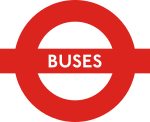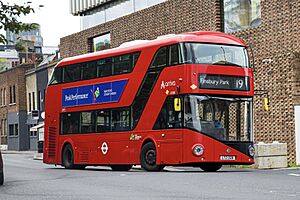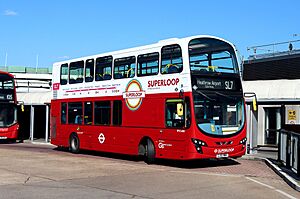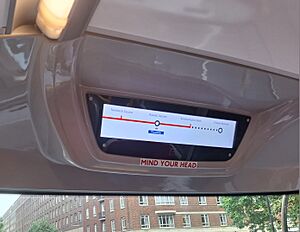London Buses facts for kids
 |
|
|---|---|

New Routemaster on route 19 at Battersea
|
|
| Parent | Transport for London |
| Founded | 11 November 1999 |
| Headquarters | London |
| Service area | Greater London Berkshire Buckinghamshire Essex Hertfordshire Kent Surrey |
| Service type | Bus transport network |
| Routes | circa 670 |
| Stops | 19,607 (2023) |
| Fleet | 8,797 (2025) |
| Daily ridership | 5.7 million (2019/20) |
| Fuel type | Diesel, Hybrid, Electric and Hydrogen fuel cell |
London Buses is the part of Transport for London (TfL) that manages most bus services in London, England. It was created in 1999 when a new law transferred control of London's bus services to TfL. The Mayor of London oversees TfL.
Contents
What London Buses Does

London Buses, through TfL, is in charge of many important things. They make sure London's bus network runs smoothly.
Here are some of their main jobs:
- Planning new bus routes and changing old ones.
- Deciding how often buses should run.
- Checking the quality of bus services.
- Managing bus stations and bus stops.
- Helping with road diversions and supporting bus drivers.
- Giving passengers information like timetables and maps.
- Creating special bus maps that are easy to understand.
- Running a 24-hour control centre called CentreComm. This centre helps manage traffic issues.
How Bus Services Work
Bus services in London are run by different private companies. These companies bid for contracts to operate specific bus routes. TfL sets the rules and guidelines for how these companies should operate.
Contracts for bus routes usually last for seven years. If a company does a good job, they can get an extra two years. The bus companies provide the buses and the drivers. TfL pays them based on how many miles each bus travels.
Bus Maps for Passengers
London Buses creates many different bus maps. In 2002, they started making "spider maps." These maps focus on one area or bus station. They show bus routes spreading out from a central point, like a spider's web. This design makes them easy to read, similar to the famous Tube map. You can find these maps at most major bus stops. You can also download them online from the TfL website.
London's Bus Network
London has one of the biggest bus networks in the world. As of March 2024, there are 8,797 buses. These buses operate on over 670 different routes. In 2019/20, people made 2.09 billion journeys on London buses.
Paying for Your Bus Journey
You can pay for bus journeys in London using several methods. These include Travelcards, Oyster cards, and contactless debit or credit cards. Since July 2014, you cannot pay with cash on London buses.
Here's how fares work:
- A single bus journey costs £1.75 as of 2025.
- The "hopper fare" was introduced in 2016. This means you can take as many buses as you like within one hour of touching in, without paying extra.
- If you use an Oyster card or contactless card, there's a "daily cap." This limits how much you pay in one day, no matter how many bus journeys you make.
- You can also buy weekly or monthly passes for your Oyster card.
- Contactless cards also have a 7-day fare cap, which runs from Monday to Sunday.
Free Travel and Discounts
Many people can travel for free or at a reduced cost:
- Children under 11 travel free on buses and trams at any time. They do not need a ticket or Oyster card.
- Children aged 11 to 15 travel free on buses with a special 11–15 Oyster photocard. Without this, they pay the adult fare.
- There are also discounts for London residents aged 16 to 18.
- The Freedom Pass allows older London residents and people with disabilities to travel free at any time.
- People with bus passes from other parts of England can also travel free on TfL bus services.
Bus Companies (Operators)
Many different companies operate bus services in London under contract to London Buses.
Current Operators
- Arriva London
- Go-Ahead London
- Metroline
- First Bus London
- Stagecoach London
- Transport UK London Bus
- Uno
Past Operators
- RATP Dev Transit London
- First London
- HCT Group
- Sullivan Buses
- Tower Transit
Each company and bus garage has its own special code.
Bus Vehicles

As of March 2025, London's bus fleet has 8,797 buses. This includes 3,776 hybrid buses, 1,951 battery electric buses, and 20 hydrogen fuel cell buses. London has the second-largest zero-emission bus fleet in Europe.
Since 2006, all London buses have been accessible and low-floor. This means they are easy for everyone to use, including people with wheelchairs or pushchairs.
Most London buses are red, which has been a rule since 1997. They also have white roofs with special markings. These markings help keep the bus cool in summer. London Buses sets rules for the types of buses used on each route. For example, many London buses have separate doors for exiting. Double-decker buses have straight staircases.
New electric single-decker buses have air conditioning that also removes humidity.
iBus System
All London buses use the iBus system. This is a special system that tracks where buses are. It also provides audio and visual announcements inside the bus, telling passengers the next stop. The iBus system can even help buses get priority at traffic lights. This system was fully in use across all bus routes by 2009.
See also
 In Spanish: London Buses para niños
In Spanish: London Buses para niños


